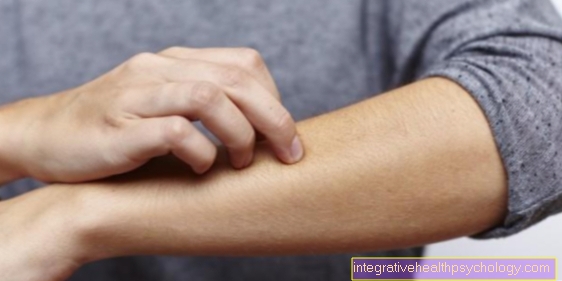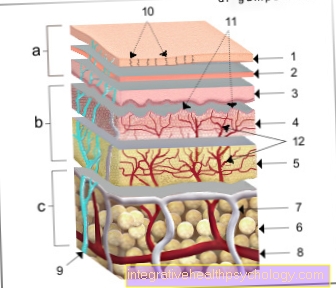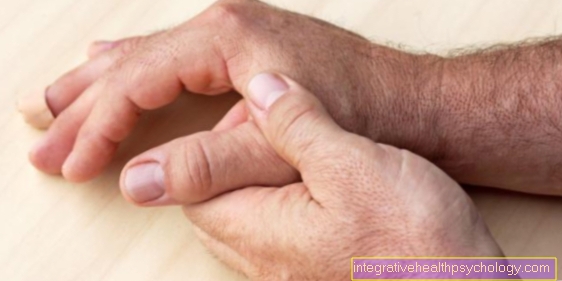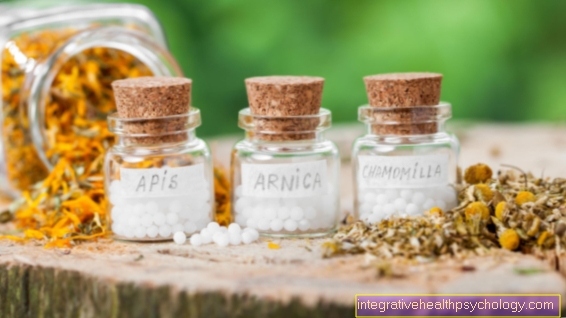The skin flora
Function of the skin flora
The skin flora is the name given to the innumerable microorganisms that colonize the skin from the outside. These include a wide variety of bacteria, spores and fungi that are permanently or only temporarily located there. The bacteria colonize the skin very densely and are an extremely important part of the healthy flora. About 1000 germs / cm2 can be found in healthy skin flora. They protect the body from pathogens as long as the skin is intact and forms a barrier. Individual regions of the body harbor different types of microorganisms. The flora on hairy parts of the body is therefore different from, for example, on the palms of the hands.

The bacteria and fungi look for the part of the body where their survival conditions are best. Factors that influence the skin flora are mainly Moisture content, pH value, fat percentage as well as the amount of Cornea, furthermore play genetic factors, age, gender or surrounding climatic conditions a role.
For example, on areas of the body that are more rich in fat, such as the nose or shoulders, mainly so-called growths Propionibacteria and Corynebacteria, because they can process the fats well. Instead, numerous fungi grow in places on the cornea, such as the soles of the feet, which can feed on the skin's keratin. If the humidity of a part of the body increases, the number of germs also increases.
Some microorganisms in the skin flora can also be potentially pathogenic and cause inflammation. But if they are in balancethat remains Barrier function of the skin and if the person's immune system is functioning adequately, they pose no risk of disease.
Due to their dense population, they make it difficult for even sick people, so-called "pathogenic“Pathogens colonize the skin. Is this balance of the microorganisms through internal or external influences disturbed, it can lead to diseases pathogenic Germs come.
Internal influences, for example, include one Adjustment of the hormonal balance during the puberty. This allows pathogenic Organisms attack and inflame the hair follicle, which is typical of the acne in adolescents. An external influence on the disruption of the skin flora can be a excessive hand hygiene be. By eliminating the healthy skin flora, more pathogenic bacteria can colonize the skin.
Classification of the skin flora
The skin flora can be divided into transiente and a resident Colonization. The terms literally mean “temporary” and “resident”. While the resident Flora permanently colonizes the skin, the microorganisms occur transient Flora only temporarily, for example through transmission from other people.
As long as the transient flora does not upset the resident flora, it poses no danger. However, in certain quantities and under various influences, the transient flora can cause disease. For this reason, attempts are made to remove the transient flora in particular during hygienic hand disinfection, as takes place in hospitals. The most important types of germs that form resident skin flora are above all Staphylococcus species, corynebacteria, propionibacteria and some fungus on the skin of the feet. The temporary flora mainly includes the Staphylococcus aureus, clostridia, mycobacteria, coli bacteria, as well as others Enterobacteria.
Under the negative connotation of the Germ is understood in general all microorganisms, make you sick. However, the germs of the skin flora denote any microorganisms that reside there or temporarily live there, pathogenic or not. Through contact with environmental factors or other people, pathogenic germs can also settle in the healthy skin flora. Is the Barrier function of the skin disturbedwho have favourited healthy Germ density too low or that Defense system of the human weakened, these germs can too Diseases to lead.
Currently, the hospitals are primarily concerned with MRSA-Germ. MRSA (Multirconstant Staphylococcus aureus) is a normal one Skin germwho only makes you sick when normal Weakened skin function is. It falls under the concept of transient Skin flora.
A variety of diseases can be triggered by the germs entering the body. The most relevant illnesses in everyday hospital life are the Wound infections, as well as infections from invasive Additions. Before through a invasive Method, the skin barrier is broken, the skin area must be thoroughly disinfected so that germs of the skin flora do not get inside the body. Disinfection must be carried out before operations, but also before placing venous accesses, urinary catheters and any other catheters, as well as before taking blood.
How can you restore the skin flora?
In our everyday environment, the skin and the skin flora are exposed to a lot of stress. With a growing awareness of bacteria, viruses, the risk of infection and hygiene, the number of skin disinfectants also increases. However, very frequent washing, showering and disinfecting can have the opposite effects. It is therefore important to find a healthy average in which the physiological skin flora is completely preserved and at the same time potentially pathogenic germs are eliminated. You can find more about this under: Correct hand washing and disinfection
When showering, the so-called protective acid mantle and parts of the resident Skin flora partially eliminated. Soaps also loosen the fats on the skin and wash them off with it. In healthy people, the flora usually degrades within a few hours. Frequent washing is particularly harmful for people with allergies or skin diseases. Since the surface of the skin has a slightly acidic pH value of around 5.5, especially alkaline soaps with a high pH value are not recommended. In some cases, soaps already exist with disinfectants added. From a medical point of view, these are rather not recommended because, with long-term use, they also primarily attack the physiologically healthy skin flora. It is recommended for the skin flora to keep the skin greasy. Excessively frequent washing degreases the skin. In contrast, moisturizing skin creams in particular help, but also shower gels that have a moisturizing effect. In hospitals you can often find hand disinfectants that are moisturizing.
Skin flora of the hand

In particular, the human hand houses the different germs. It also has a naturally occurring, healthy bacterial flora. Lively contact and contact with other people and the environment also lead to many potentially harmful bacteria. The risk of infection with these germs, by reaching into the mouth or on the eyes or by touching the food is through the hands elevated. For this reason, before engaging in any activity that may cause infection, it is important transient Eliminate flora of the hand as much as possible. In everyday use, this can be done regular hand washing accomplish.
in the Hospital operations must be a Hand disinfection be performed. In every hospital room there is the possibility of doing this with the help of an alcoholic solution, whereby the liquid should be rubbed into the hands for 30 seconds. So that the resident skin flora does not suffer from permanent disinfection, constant care of the hands with the help of creams is recommended, especially for hospital staff.
Figure skin

a - epidermis (1. - 3.) - epidermis
b - dermis (4. - 5.) - Dermis
c - subcutaneous tissue (6.) - Tela subcutanea
- Horny layer - Stratum corneum
- Cornifying layer
(light layer
and granular layer) -
Stratum lucidum and
Stratum granulosum - Germ layer (prickly cell layer
and base layer) -
Stratum spinosum and
Stratum basale - Papillary layer -
Stratum papillary - Network layer - Stratum reticularre
- Subcutaneous tissue - Tela subcutanea
- Lymph vessel - Vas lymphaticum
- Artery - Artery
- Cutaneous nerve - Cutaneous nerve
- Duct of a sweat gland - Ductus sudorifer
- Papillae of the dermis - Papillae (dermidis)
- Vascular network of the dermis - Subpapillary venous plexus
You can find an overview of all Dr-Gumpert images at: medical illustrations





























